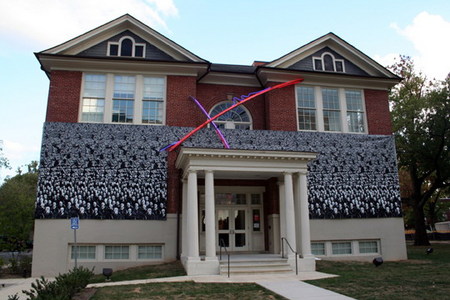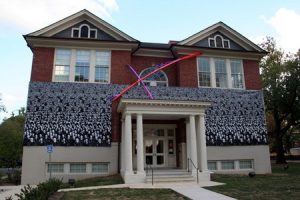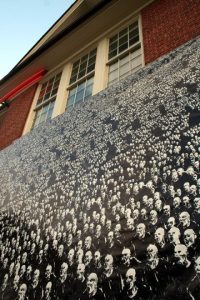A Great Big “0”
Digital technology enables the mass production of Rosemary Feit Covey’s Project 0.
By Steve Aust
Rosemary Feit Covey, a South African-born artist, has earned space at such prestigious institutions as the National Museum of American History, the Corcoran Gallery of Art and Cairo’s Papyrus Institute. Simon & Schuster and Morrow Publishing Co. have also published her book illustrations. For years, the crux of her art entailed laboriously handcrafting prints on handmade Japanese papers using wood letterforms and a hand-run, Vandercock press. However, one day, a child’s earnest question triggered a revelation.
“He was watching me work through this meticulous process, and he said, ‘Why don’t you just Xerox® it?” Covey said. “I’d spent 30 years as a professional artist perfecting ancient wood-engraving techniques. But, upon reflection, I realized that mass-produced or computer-generated art was equally relevant.”
Thus, the 0 (as in “zero”, not the letter “o”) Project was born. She christened it because 0 contains no inherent value, and it signifies that artistic interpretation and merit reside in the viewer’s opinion, not the artist’s. Covey developed the tableau of slightly sketchy, black-clad, scowling figures against a grayish-black backdrop. It began as a wall-mounted piece in her studio, but it provoked such strong reactions from visitors that she decided to produce it on a grander scale as an outdoor building wrap.
Advertisement
After being selected from hundreds of applicants from through the mid-Atlantic region, she discussed the concept with Claire Huschle, executive director of the Arlington (VA) Arts Center, and they agreed to encircle the building with a 15-ft.-tall, 300-ft.-long depiction of Project 0. Jeffrey Cudlin, the Center’s director of exhibitions, viewed it as an apt representation of the Center’s mission.
“It’s our goal to present the most diverse and challenging works of contemporary art,” he said. “We’re excited for the opportunity to present such an unusual, innovative piece that invites visitor reaction and interpretation.”
As with any highly public piece of artwork, hurdles loomed. The Center needed a special permit to install the piece, and it had to pass muster with the local Historical Society (often a paramount concern in the centuries-old cities that surround Washington D.C.) Even the local PTA expressed concern that a grand-format rendering of spectral, menacing figures would frighten passing schoolchildren. Finally, the Center assuaged all concerns, and the project proceeded.
To produce the wrap, Covey found Scott Snoyer, proprietor of FastSigns’ Antioch, TN-based franchise. A former tennis professional, he’d developed a behemoth shop that outpaced a garden-variety franchise – he’ll be moving from a 4,600- to a 9,000-sq.-ft. shop in December. His staff outputs several vehicle wraps monthly, but this was his first opportunity to fabricate a building wrap.
Snoyer contacted Curt Oberholtzer, account manager for DuPont™ Tyvek® graphics division. From past experience, Covey was familiar with the Tyvek print media and wanted to determine whether the application was appropriate for this substrate.
“Initially, Rosemary wanted to have it printed on a water-based ink system, but testing determined this wouldn’t last in an outdoor environment. We determined that a UV-ink printing system would be the best because it wouldn’t require a protective coating for the media.”
Advertisement
Ultimately, Snoyer, Covey, Oberholtzer and other DuPont representatives selected Tyvek 1085D material. Its integral weight of 3.2 oz per sq. yd., considerably lighter than most banner materials’ 10 to 13 oz., would later prove advantageous for installation.
Having chosen a media, Snoyer proceeded with the output. Using a bitmap file supplied by Dodge Color (Silver Spring, MD), he adjusted the monochromatic piece by making the backdrop blacker for greater contrast. He refined the design in Photoshop and output it on his EFI-VUTEk QS 200 UV-cure printer in 30-ft.-long panels.
Finally, Cudlin and the Center’s staff tackled Project 0’s installation. Initially, he’d considered installing the wrap with lag screws, but realized this would risk ripping holes in the material. They also had to fit the wrap around a neon sculpture that had been installed on the roof. After having consulted with Snoyer, Cudlin and his staff built a frame of 15-ft.-long 2 x 4s that vertically and horizontally support the wrap. They affixed the media to the surface with staples and heavy-duty Tyvek tape. Though the entire team had reservations about cutting slits into the wrap, they considered it necessary to mitigate wind shear. To minimize the aesthetic impact, they installed a thin vinyl layer underneath.
The building wrap will remain in place until March 1. Concurrently, Covey has transformed Project 0 into a multimedia work – she’s licensed the printing of T-shirts with the image and also offers it as a screen projection onto buildings and stages. For Covey, the Project’s diverse formats underscore its vitality.
“Project 0 has no beginning and no end,” she said. “It’s alive because the viewer keeps it alive, and diverse technologies help it evolve as an unfolding artistic experience.”



 Photo Gallery1 week ago
Photo Gallery1 week ago
 Ask Signs of the Times2 weeks ago
Ask Signs of the Times2 weeks ago
 Paula Fargo1 week ago
Paula Fargo1 week ago
 Real Deal5 days ago
Real Deal5 days ago
 Photo Gallery1 week ago
Photo Gallery1 week ago
 Women in Signs2 weeks ago
Women in Signs2 weeks ago
 Women in Signs2 weeks ago
Women in Signs2 weeks ago
 Projects5 days ago
Projects5 days ago











